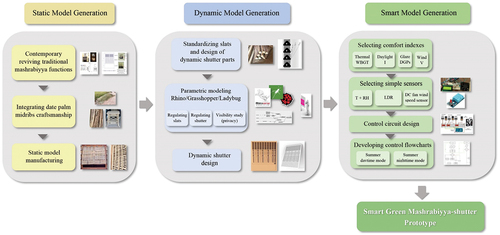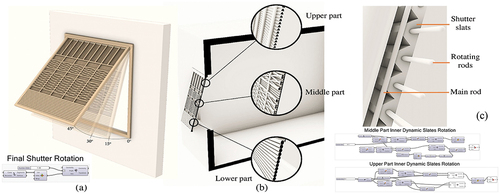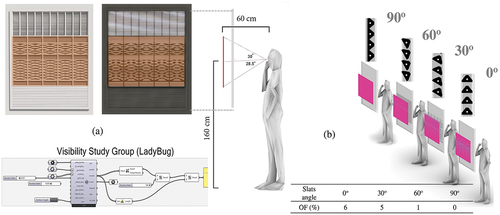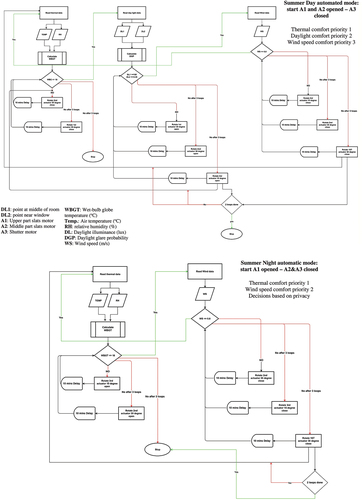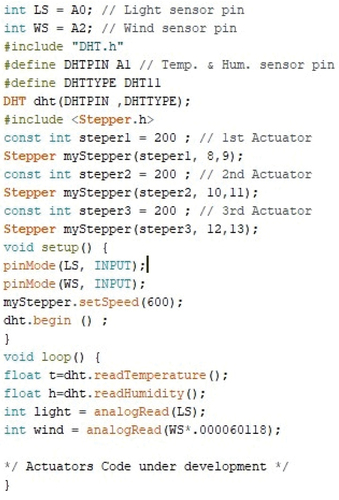 ?Mathematical formulae have been encoded as MathML and are displayed in this HTML version using MathJax in order to improve their display. Uncheck the box to turn MathJax off. This feature requires Javascript. Click on a formula to zoom.
?Mathematical formulae have been encoded as MathML and are displayed in this HTML version using MathJax in order to improve their display. Uncheck the box to turn MathJax off. This feature requires Javascript. Click on a formula to zoom.ABSTRACT
The revival of traditional latticework mashrabiyya is continually urged in the Middle East and North Africa to address conflicting needs since it optimally balances environmental, social, and aesthetic functions. However, its material and craftsmanship costs and inflexibility are significant barriers. This study aims to provide a preliminary design for a green, smart mashrabiyya-like shutter responsive to climatic conditions and privacy needs in Egypt, manufactured with palm midribs, a waste material available in the MENA region due to annual trimming. The simple, yet responsive and traditional design outlined in this study has a considerable potential for residential applications not only in Egypt, but also in similar socio-environmental contexts. The design generation is based on three steps: 1) constructing a static model that maintains the basic socio-environmental needs, manufactured with palm midrib patterns, 2) modeling dynamic functions, using Grasshopper/Ladybug, through standardizing slats and deciding upon visibility and adjustable parts, and 3) integrating smart controls based on comfort indexes and indoor climatic readings. Using a simple circuit fitted with sensors, actuators, and a microcontroller, the design of a latticework shutter responsive to climate and privacy was generated. The concept depends on computing indoor weather data and comparing them to thermal, daylight, and wind comfort indexes. Consequently, automated decisions could be made to regulate the shutter parts in two ways: 1) its opening angle and 2) openness between the slats. Ultimately, the operating concept of the smart shutter in a room and automated flowcharts that make decisions in daytime and nighttime modes were proposed.
Introduction
The current study aims to provide a preliminary conceptual design for a green, smart mashrabiyya-like shutter for residential applications that is responsive to climate and privacy requirements. To reach this goal, the paper begins by looking into the research background, explaining the objectives, and providing a literature review on this topic. Second, it describes the materials and methods used to achieve this goal, including the methodology followed, the suggested functions and materials of the shutter, its design tools and software, and selected comfort indexes. Finally, the findings present and discuss the proposed dynamic shutter, which includes integrated smart controls, an electronic circuit, and automated flowcharts.
Research background
Most urban and increasingly rural households in Egypt live in apartment blocks. Their façades often incorporate glass panels and wood shutters called sheesh. Windows with glass panels, open balconies, and Venetian blinds known as sheesh were discovered as early as the 1870s. Khedive Ismail of Egypt reigned from 1863 until 1879, and his involvement at the Exposition Universelle in Paris impacted his architectural style. The large numbers of Italian architects and technicians hired by the Egyptian Ministry of Public Works, as well as the owners of private palaces and mansions, are attributed to their clear Italian influences [Citation1,Citation2]. Sheesh-related concerns were numerically investigated by Abdel Gelil M. and Badawy [Citation3]. While it keeps direct sunlight out and offers privacy, it restricts ventilation, natural light, and views. When the window is opened for ventilation, it creates glare, sun exposure, and a loss of privacy. Sheesh is becoming less popular as a result of the exorbitant expense of imported wood. True, wood is a low-carbon resource that needs little energy; however, several countries import wood to suit local needs. It becomes unsustainable when imported, since 30% of its emissions originate from production and 70% from international trade [Citation4,Citation5]. In addition, Egypt’s market is entirely dependent on imported raw wood since, like the majority of Arab nations, it is arid and has little vegetation. For instance, to satisfy local demand, more than 4 million cubic meters of sawnwood and roundwood were imported in 2020 [Citation6], making wood expensive and ecologically hazardous. A number of architects and researchers in the Arab world are advocating for the revival of the Islamic latticework known as mashrabiyya () in order to solve issues related to heat stress and social norms, as it optimally balances social and environmental concerns [Citation7]. It refers to a turned wood process used to create lattice-like screens to embellish windows in traditional residential architecture. In Egypt, the word mashrabiyya is derived from the Arabic verb shariba, ‘to drink’, and originally described a place for drinking. It was also said that the term is derived from the word Musharrafiya, i.e. the place from which women overlook the outside. Lane [Citation8] defined a mashrabiyya as a piece of latticework from which small sections projected; these sections were used to put and cool earthen water drinking bottles by exposing them to airflow [Citation8–10].
Mashrabiyya is connected with 16th–19th-century Egyptian urban architecture, where main goals were to keep Muslim women from being seen by men and to help with the heat and dryness of the weather. Its parts include [Citation7,Citation11–13]: 1) The primary mashrabiyya, which consists of a lower part below the eye level with a tight latticework and an upper part above the eye level with a wide lattice pattern. The bottom half provided privacy and shade from Cairo’s harsh weather, while the top part allowed for light and ventilation. 2) An overhang directly above the mashrabiyya to prevent sun from penetrating through the top section’s more open latticework. Currently, mashrabiyyas are seldom utilized for windows or balconies [Citation14]. Its superior craftsmanship, high expense, difficulty in maintenance, lack of adaptability, and changes in urban surroundings are significant barriers to its reintroduction. Abdel Gelil M. [Citation12] and Abdel Gelil M. and Badawy [Citation3] attempted to develop a simple mashrabiyya shutter for Egyptian residences.
In contrast, date palm midribs have been used as an alternative to wood in countryside areas for generations and are abundant in North Africa and the Middle East owing to yearly trimming [Citation15,Citation16]. These regions alone account for 90% of worldwide date harvest, with Egypt leading the way in 2020 (18%) [Citation17]. The date palm may survive for 100 years, producing around 13 leaves per palm as agricultural waste [Citation16]. In rural areas, midribs are being used instead of wood to make roofs, fences, furniture, and crates; and leaflets are used in tools like baskets and brooms [Citation15,Citation18]. Despite being technologically advanced, the advent of plastic and changing Egyptian consumer habits have resulted in a reduction in date palm-related commodities since the mid-20th century [Citation15]. Ain Shams University academics have been experimenting with date palm leaf midrib (DPLM) as a wood replacement since 1991. Because of its distinctive flexible tissue, which can resist scorching desert winds and millions of cyclic loads without cracking [Citation15,Citation16,Citation19], it possesses physio-mechanical properties comparable to conventional timbers [Citation15,Citation20]. Efforts were made to use the material to manufacture boards and blocks, but their applications are confined to small-scale products owing to costly machines and time-consuming processing [Citation15,Citation20,Citation21].
Research aim
This study aims to provide a preliminary conceptual design for a green, smart mashrabiyya-like shutter responsive to climate and privacy requirements, for residential applications. The proposed system consists of a combination of latticework patterns utilizing DPLM craftsmanship, as well as smart functions to control heat stress, daylight, glare, and wind velocity. The automated concept is based on monitoring indoor climatic data and calculating comfort levels, with thermal comfort given the highest priority, and the need for privacy is taken into account during design and operation. The adaptive model relies on simple, low-cost solutions to make its implementation in residential contexts feasible. The paper discusses previous research on the subject, the materials and methods used to develop the design, and the static, dynamic, and smart design and functions used to generate the proposed shutter concept. At the end, it proposes a control circuit design equipped with sensors, actuators, and controllers, describes how the system works in a room, and provides potential flowcharts for daytime and nighttime automated modes in summer.
Literature review
The majority of responsive façade research focuses on expensive high-tech smart features and glazing improvement, addresses domestic static blinds, or proposes dynamic blinds for offices and commercial buildings with an emphasis on illumination and glare. Responsive or dynamic façades are envelopes that can respond to weather and seasonal trends [Citation22]. According to COST Action-Adaptive Façades Network, such façades have a significant influence on occupant satisfaction, energy conservation, and environmental impact mitigation [Citation22,Citation23]. The survey conducted by Attia, et al. [Citation22] found that occupant comfort and decentralized control via customization and smart automation have emerged as the most leading trends on the market of adaptable façade technologies and solutions. Extensive analysis in the same survey defines adaptive façade technologies into four categories: ‘dynamic shading’, ‘chromogenic’, ‘solar active’, and ‘active ventilated’ façades. Changing from static to responsive building façades, however, is often associated with increased expenses [Citation24], complexity in terms of the system, and contradictory functions to meet varying needs [Citation25]. The solutions found in the literature mainly concentrate on the thermal behavior and insulating performance of walls and windows [Citation23], as well as costly high-tech smart features, which indeed have a significant influence on decreasing heating and cooling expenses in buildings compared to traditional window systems [Citation24]. The majority of window-related research has been on the improvement of glazing behavior, such as the exploration of novel window material, the enhancement of the optical characteristics of glazing, and thermal bridges [Citation23]. Jiang, et al. [Citation26] proposed using a thermo-response hydrogel smart window component for dynamic solar control of commercial façades. Fazel, et al. [Citation24] offer smart window glazing that changes based on the temperature and the laws of thermodynamics.
Literature on shutters and blinds define them as basic window treatments that decrease energy consumption with a lower economic effect than solutions that concentrate on glass. Blinds might be divided into three categories [Citation23,Citation27]: 1) static blinds with no control over their sections; 2) manually operated blinds that are regulated by the occupants depending on their own preferences; they often do not fulfil thermal, lighting, and visual performance standards; 3) dynamic blinds with automatic control (type 1 in Attia, et al. [Citation22]‘s classification), responsive to direct sunrays, indoor temperature and light levels. This might be further evolved into split-controlled blinds, which have a more complicated design so that multiple sectors can be controlled independently. Previous research focused on static blinds for domestic applications or dynamic blinds for office and commercial buildings [Citation23]. For example, Krippner and Bonfig [Citation28] created a static blind shutter utilizing semi-transparent biopolymer sheets inspired by the Japanese shoji. It enables sunshine to pass through while preventing glare. Two levels of vertically movable louvers were set behind each other to manage the sun and view. However, the blinds have to be configured differently based on the installed façade. Olbina and Hu [Citation27] proposed dynamic split-controlled blinds to achieve two goals: 1) decreasing energy demand for HVAC and artificial lighting; and 2) boosting illuminance levels by enhancing daylight penetration. The blind has three sections, and the louvers may be rotated according to two preferences: vision or daylighting. To provide enough illumination and minimize glare, two sensors were fitted to detect illuminance levels close to and distant from the window. The automatic control approach was designed with the sole purpose of increasing the degree of illumination while reducing glare. The thermal performance of the device was tested in the research, although thermal comfort was not included in the blind’s control. Do and Chan [Citation29] designed an automated shade that could control light, glare, and view for a glazed office space façade.
Materials and methods
The sections that follow describe the methodology employed for generating the smart green shutter design; detail the static shutter, including its parts, functions, materials, and craftsmanship; shed light on the software utilized to create the dynamic and smart shutter designs; and finally, analyze the selection of the thermal, daylight, and wind comfort indexes based on Cairo city’s climate data. It is vital to note that a static shutter was designed and constructed based on earlier research [Citation3,Citation12].
Design methodology
The design methodology () is based on three steps: 1) developing a static design that maintains the basic balance between environmental and social needs while experimenting its manufacture using palm midrib craftsmanship. 2) adding dynamic split-controlled functions through standardizing midribs slats and deciding upon adjustable sections using parametric modeling software 3) smart controlling of the dynamic parts based on indoor climatic readings and comfort indexes. This step starts by determining comfort indexes, selecting simple sensors and actuators, design and coding of the control circuit, and finally developing control flowcharts for the automated decisions.
Manufacturing of the static shutter
During annual pruning, palm leaves are detached from the palm at a length determined by cultural norms and are typically between 3 and 6 meters in length [Citation18]. The midrib is then obtained by cutting the leaflets; its cross section is triangular () that becomes increasingly thinner toward the end to be almost a circle. After that, it is sliced into slats of varying thickness and standard length and interconnected to create patterns of latticework. The lengths and cross sections of the slats were standardized to triangles and circles in order to create the prototype. Simultaneously, the slats were arranged so that DPLM patterns were maintained. A pesticide was applied to the shutter to protect it from mites.
Figure 3. Date palm midribs. (a) whole leaves, (b) cross-section, (c) slats, (d) common table. (photos by the author).

The model was initially manufactured using furniture techniques and manual tools with the integration of the craftsmanship patterns, and its main parts and functions were inspired from the traditional mashrabiyya functions (). The shutter is divided into 3 parts: 1) An upper part with wide latticework that allows for more lighting and airflow. 2) A middle (main) part with tight latticework that ensures privacy and provides natural lighting and ventilation while breaking direct sun. 3) A closed lower part to reduce heat and to function as a base. The whole shutter opens upward for increased lighting and ventilation while providing privacy. The first step to transform the shutter into a smart climate-responsive device, dynamic features had to be added to its static status as explained in the following sections.
Software utilized for the shutter design
‘Grasshopper’ v1.0.0007 was used to perform the entire shutter modeling, whilst ‘Rhinoceros’ v7.12.21313 was utilized for visualization. The objective was to enable independent adjustment of the top and middle part slats as well as the angle of the shutter’s opening. The integrated Grasshopper tool ‘Ladybug’ v1.5.1 was employed to undertake a visibility study to determine the openness factor (OF) for privacy. All of the shutter parts can be customized, which is a benefit of using parametric tools to build the whole model. The automated control circuit was designed using the open-source PCB tool ‘fritzing’ v.0.9.3b, the control flowchart was drawn with the diagram tool ‘draw.io’ v.20.3.0, and the code was developed with the free-source software ‘Arduino IDE’ v.1.8.19.
Selecting comfort indexes
The concept of the shutter is based on computing indoor weather data and comparing it to thermal, daylight, and wind comfort indexes. As a result, the shutter system makes automated decisions to regulate its adjustable parts in order to achieve the internal user’s comfort. The sections that follow provide a more detailed explanation of Cairo’s climatic data as well as the selection of these indexes.
Climate of Cairo
According to the Koppen-Geiger classification system, Egypt has a desert climate (BWh) typified by hot, dry summers from May to September, temperate winters, and little precipitation, mostly around the coasts () [Citation30]. Summer temperatures range from 35–38° (mean daily maximum) to 16–21° (mean daily minimum), and winds are particularly strong near the Red Sea (8.0–10.0 m/s) and Mediterranean shores (6.0–6.5 m/s). Egypt is also subject to ‘khamasin’ winds, which bring sand and dust to northern Africa. Typically occurring between March and May, these khamasin storms may raise the temperature by 20°C and can persist for many days [Citation31,Citation32].
Figure 5. Annual temperature and wind velocities in Cairo. Left, average temperatures; right, wind velocities according to no. Of days [Citation30].
![Figure 5. Annual temperature and wind velocities in Cairo. Left, average temperatures; right, wind velocities according to no. Of days [Citation30].](/cms/asset/b111de3a-2ec6-4a03-84bb-e5e2ee1eb56b/thbr_a_2259629_f0005_oc.jpg)
Thermal comfort index
Common heat stress indexes include Universal Thermal Climate Index (UTCI), Wet Bulb Globe Temperature (WBGT), Predicted Mean Vote (PMV), Predicted Percentage Dissatisfied (PPD), Standard Effective Temperature (SET), and Physiological Equivalent Temperature (PET). Zare, et al. [Citation33] carefully compared the precision of their respective results. It was shown that UTCI, SET, PET, and WBGT all exhibited strong correlations, although UTCI and WBGT are more comparable than the other indices, with the exception of the latter, which may be used to measure thermal comfort both inside and outside. While PMV and PPD assess indoor heat stress, the results are frequently criticized for grossly overestimating or underestimating heat stress (according to season) in naturally ventilated spaces and for being more appropriate for mechanically heated, cooled, or ventilated indoor spaces [Citation34,Citation35]. Developed by Yaglou and Minard in 1957, WBGT is widely employed in heat stress evaluation [Citation33,Citation35,Citation36]. This indicator provides a more precise result than known simple heat indexes since it considers four variables: temperature, humidity, wind, and radiation [Citation33,Citation36,Citation37]. Lemke and Kjellstrom [Citation36] determined that for measuring WBGT, it is more accurate to compute its value using meteorological data as opposed to using traditional thermometers directly. The research examined the most prevalent equations for calculating WBGT and determined that the Bernard formula is the best for calculating WBGTid (indoors). The formula has been thoroughly evaluated and verified by Bernard and Pourmoghani [Citation38], and used in subsequent studies [Citation35]. EquationEquations 1(1)
(1) and Equation2
(2)
(2) are for calculating outdoor and indoor WBGT respectively:
Tg denotes the ‘globe temperature’ as detected by a thermometer placed in a black globe (to estimate solar radiation), T denotes the dry air temperature, and Tw denotes the natural ‘wet bulb temperature’. Assuming that there is no local source of heat radiation inside, Tg=T, the equation is:
Bernard calculates the WBGTid using 1 m/s wind velocity because humans generate an actual wind velocity of at least 1 m/s when moving their arms and legs; additionally, higher wind velocities have no discernible effect on the WBGTid [Citation35]. Tw is precalculated using Stull formula (EquationEquation 3(3)
(3) ) [Citation39] which allows the calculation using measurements acquired from air temperature (T) and RH meters:
WBGT limits are shown in , where below 18°C means no heat stress is experienced.
Table 1. WBGT levels (oC) [Citation33].
Daylight illuminance and daylight glare probability
The daylight needs for residential spaces are difficult to generalize since they are strongly dependent on user behavior and individual requirements [Citation40]. For office environments, the European Standards (EN17037) and the usable daylight illuminance recommended by Mardaljevic and Nabil specify a minimum of 100 lux [Citation27,Citation41,Citation42]. The typical necessary illuminance levels in domestic areas range from 100 to 200 lux; with the exception of the kitchen, all other zones requiring 100–150 lux illuminance levels [Citation40,Citation43]. Most humans also seem to tolerate far lower natural illuminance levels than artificial ones [Citation3]. While a minimum acceptable illuminance of 100 lux should be maintained, high brightness levels may result in glare [Citation27,Citation41,Citation42]. CGI, DGI, UGR, VCP, and DGP are among the indices that seek to identify uncomfortable glare, despite its subjective nature. With the exception of ‘daylight glare probability’ (DGP), which accounts for vertical illuminance, these metrics primarily consider the background and source contrast. In addition, only the ‘daylight glare index’ (DGI) and DGP are designed to evaluate glare from natural daylight [Citation42], with the earlier being developed to detect glare from large sources [Citation44]. Wienold and Christoffersen [Citation44] proposed using vertical eye illuminance as a metric for DGI adaption. They created the Daylight Glare Probability after conducting extensive testing with 76 people under varied real-world daylight circumstances [Citation42,Citation44]. In 2009, Wienold developed and verified a simpler version of DGP (DGPs) based on vertical eye illuminance, used when neither sun radiation nor its specular reflections strikes the eye [Citation42]. Wienold and Christoffersen [Citation44] found a high connection between vertical illuminance and experienced glare by users, suggesting that ‘vertical illuminance at eye level’ is an indicator of uncomfortable glare [Citation42]. Because the DGPs relies only on vertical eye illuminance (Ev), the value may be simply determined with a single calculation point using EquationEquation (4)(4)
(4) ; its levels are shown in :
Table 2. Simplified daylight glare probability levels [Citation29].
DGPs were recently used in Do and Chan [Citation29] study to maintain glare at an imperceptible level for an automated, adjustable roller shade. If DGP equals or is less than 0.35, glare is classified as imperceptible. The shutter prototype presented in the present research is intended to detect illumination at two sensor locations: one near the shutter to evaluate glare and one in the middle of the room to assess daylight. The glare at the first point should not exceed 0.35 (illuminance = 2670 lux), and the illuminance at the second point should not be less than 100 lux.
Wind comfort
According to ANSI/ASHRAE Standard 55–2013, the average airflow velocity in HVAC buildings is typically less than 0.2 m/s, whereas the maximum velocity with occupant control should not exceed 1.2 m/s in naturally ventilated buildings. If occupants have no influence over the local wind velocity, it should not exceed 0.8 m/s at operative temperatures between 25.5°C and 30°C, based on an insulation value of 0.5 clo for summer clothes. The standard has also mentioned the possibility of discomfort from draughts at temperatures below 25.5°C [Citation45–47].
Results and discussion
The research outcomes in the following sections propose a mashrabiyya-like shutter with climate-responsive dynamic functions that allow for the adjustment of its parts; the results also suggest smart automated controls with a fully integrated control circuit.
Proposed dynamic shutter design
The sections that follow describe the design and functionality of the main parts of the dynamic shutter, as well as the DPLM slats design in relation to the material’s natural shape and summer sun altitudes. A visibility study that determines the openness factor of the intervals between the slats for privacy considerations is also provided.
Main parts
The dynamic model design () serves three main purposes: 1) The upper part has a wide latticework arranged in two layers with its inner slats rotating horizontally to provide light and air; 2) the middle part provides privacy, light, and air while protecting from heat and glare. It has a tight latticework that is also arranged in two layers, with its inner slats rotating horizontally and its outer slats fixed and arranged in a tight pattern, and 3) the entire shutter can move upward and downward to give user more control over the amount of daylight, air, and privacy. The shutter also has a closed lower part that functions as a base and protects against climatic conditions at that level. Two vertical rods, one on each side, are attached to the upper and middle slats to allow them to rotate. The triangular cross-section of the horizontal rotating slats was chosen not only to follow the shape of the midrib but also because it could break sun rays and reduce glare due to its two inclined surfaces.
Slats design
As stated earlier, slats shapes were determined based on the palm midribs triangular and circular cross-sections, where the main movable slats are triangular (upper and middle parts) and the tight fixed slats are circular (middle and lower parts). They were designed to intercept all direct sunrays from May to September (hottest months) considering the sun altitudes from 12:00 noon to 3:00 pm in Cairo [Citation48]. The shutter can therefore be installed in any façade (see and ).
Figure 7. Slats cross-section design based on summer sun altitudes in Cairo. Left, sun altitude at 12:00 noon; right, sun altitude at 3:00 pm. (the authors).
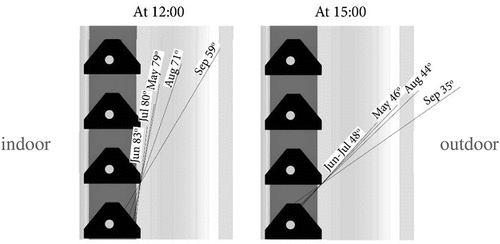
Table 3. Sun altitudes in summer from 12:00 noon to 3:00 pm in Cairo [Citation48].
Visibility study
The openness factor (OF, in percent) specifies the capacity to see through the shades, allowing for a view even when the shades are closed [Citation29]. According to Ariosto, et al. [Citation49], The openness of the slats has a significant impact on the functioning of venetian blinds. Major improvements in UV reduction are seen with an OF of 5% or less, which is the standard of the majority of shades on the market. OF is a crucial characteristic that not only impacts the thermal efficiency of the blinds but also their degree of privacy. Although privacy is fundamentally a subjective quality, the indoor view index (the view from the outside to the inside) may serve as an indication of privacy levels. When OF is between 5% and 25% for light-colored screens, the indoor view index (from the outside) is zero, indicating complete privacy, and the outdoor view index (the view from inside to outside) varies between 0.75 and 0.83, indicating a nearly transparent view. The reflections from the external slats to the outdoor viewer limit the inside vision, especially at high levels of external light (i.e. daytime), obstructing the indoor view during the day while preserving the complete outdoor view [Citation29,Citation50]. A visibility analysis was carried out using Ladybug, a Grasshopper tool, and was based on the maximum angle of view from the outside through the middle section at a height of 1.60 m (). The slat spacings and front lattice pattern widths were determined using a 5% openness factor when the slats are at 30°. Four OFs are possible: 6% when completely opened (0°), 5% when closed 30°, 1% when closed 60°, and 0% when fully closed (90°). Using this parametric tool, one may adapt the shutter design before its production to the preferred OF by altering two parameters: the spacing between rotating horizontal slats and the sizes of the front patterned lattice.
Smart controls of the mashrabiyya-shutter
A complete control circuit that consists of actuators (motors), a microcontroller kit (connecting board and software), and climatic measurement sensors makes up the smart automated control of the proposed shutter. The following sections will provide an explanation of these components as well as the main operating concept of the circuit and its automated decision flowcharts.
Control circuit design
The designed automated control circuit consists of sensors, actuators and a control unit as shown in . The selection of components () is based on their availability in the market, price, accuracy and simplicity. They are described in the following sections.
Figure 9. Control circuit design. Left, circuit components and design; right, laboratory testing of components. (the authors).
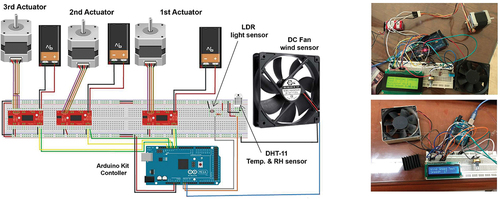
Table 4. Circuit components of the automated shutter. (the authors).
Sensors
The DHT-11 digital temperature and humidity sensor is recommended for detecting ambient temperature and relative humidity. The sensor has a temperature and humidity measuring component, as well as an 8-bit microcontroller for better quality, rapid response, and anti-interference capability. This device’s main features are that it can obtain information on a single data pin, is small, has a low power range (3 V–5 V), and can send signals up to 20 m away. These features make it one of the most widely used sensors [Citation51,Citation52]. Photoresistors, also known as light dependent resistors (LDR), are suggested for measuring illuminance. The LDR is a variable resistor composed of semiconductor material, and its resistance varies with the intensity of incoming light. The sensor has been thoroughly researched and is employed in a variety of applications, including light sensing and control. It has a basic form, very low power consumption, and is the most affordable light sensor on the market [Citation53,Citation54]. Although anemometers are often used to detect wind velocity, it was found that they were unaffordable. Instead, a simulation circuit that relies on the spinning of a conventional 3-wire computer fan’s DC motor was used. The circuit consists of the fan, the Arduino microcontroller and software (IDE), and a resistor. A pulse from an internal sensor (a hall-effect sensor) that detects the rotation of the magnets in the motor may be read while the fan rotates. This simple wind velocity measurement was calibrated using EquationEquation (5)(5)
(5) and is suggested to estimate wind velocity in residential areas. It was based on the relationship between the angular fan velocity (in rpm) and linear velocity (m/s).
Actuators
A stepper motor is a DC motor whose rotor position can be accurately controlled and which operates in discrete steps. It has several coils, with each phase being powered to create rotation in increments. Stepper motors are the best choice for most applications where precise motion control is needed [Citation55,Citation56].
Controller
An Arduino controller is recommended for controlling the proposed shutter. It is an open-source microcontroller board that is simple to programme because of its USB connection and Arduino IDE software [Citation57].
Operating system of the smart shutter
Operating concept of the smart control circuit is based on calculating comfort indexes, comparing them to actual climatic data, and then making mechanical decisions based on predesigned automated flowcharts and codes. This is illustrated in more detail below.
Main concept
The shutter is controlled through computing comfort levels as follows:
Thermal comfort index WBGT is calculated based on Equation 2, explained earlier, using air temperature and humidity (≤18°C).
Daylight comfort is assessed through measuring illuminance in the middle of the room (≥100 lux) and glare based on the DGP calculated using the illuminance at window level (≤0.35).
The wind velocity is measured in the middle of the room (≤0.8 m/s).
The sensors read meteorological data and transfer it to the Arduino microcontroller board, as shown in . Based on the comfort levels, flowcharts, and codes, the Arduino IDE software makes mechanical decisions that operate actuators 1 and 2 (A1 & A2, connected to the rods that spin the top and middle horizontal slats) and actuator 3 (A3, attached to the handle that moves the whole shutter frame upward and downward).
Automated flowcharts for summer daytime and nighttime modes
As shown in , the Day Mode begins with the upper and middle parts opened at 6% OF (0°) to provide light and ventilation (privacy is already ensured during the daytime). Thermal comfort is given the highest priority, followed by daylight comfort, and finally wind comfort.
Figure 11. Simplified description of the automated decisions in day mode and night mode in summer. (the authors).
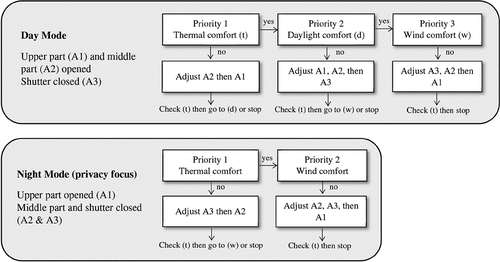
The main shutter is closed downwards to prevent heat stress. If the WBGT comfort level (≤ 18°C) is not met, decisions are taken to alter the middle part slats (A2) (the upper part compensates for light and ventilation). Three 30° closing loops are made until thermal comfort is reached (10 min delay). The same adjustments are then made to the upper part (A1). If not met, the system will stop. If reached, Arduino checks for daylight comfort (I ≥ 100 lux at DL1; DGP ≤ 0.35 at DL2) and begins regulating the upper part by rotating the slats to open 30° at a time (three loops), followed by the middle part (three loops), and finally the whole shutter (A3) by 15° at a time (thermal check is performed at the end whether comfort is reached or not). After achieving thermal and daylight comforts, the system checks wind comfort (≤0.8 m/s). If comfort is not achieved, the mechanism closes the shutter downward (A3), then the middle part (A2), and finally the upper part (A1). In Night Mode, the system begins with the upper and middle parts open, and the shutter closed downward (privacy focus). The system regulates the shutter by opening it upward at 15° angles (A3), followed by the middle part. The wind comfort is managed similarly to Day Mode. A preliminary code for the control circuit components is proposed in , while the complete code is under development.
Conclusion
The majority of responsive façade research focuses on expensive high-tech smart features and glazing improvement, addresses domestic static blinds, or proposes dynamic blinds for offices and commercial buildings with an emphasis on illumination and glare. This research presented a simple, yet responsive smart green shutter that is adaptive to climate and privacy requirements, manufactured with a local material. The device is inspired from traditional mashrabiyya, which optimally combined environmental, social, and aesthetic considerations, and is proposed to replace existing window treatments that fail to satisfy competing environmental and social needs. The study outlined the static, dynamic, and smart design and operations of the proposed shutter as follows:
The static design consists of three major slatted parts and features latticework patterns created of date palm leaf midribs, a waste material utilized as a wood alternative in rural areas and readily available owing to annual trimming.
Its dynamic components perform three primary functions: 1) an upper wide latticework arranged in two layers, with its inner slats rotating horizontally to provide daylight and air; 2) a middle part arranged in two layers, with its inner slats rotating horizontally and its outer slats assembled in a tight pattern to provide privacy, daylight, and air while protecting from heat and glare; and 3) the entire shutter moves upward and downward to allow for greater control over the degree of daylight, air and privacy. A privacy visibility analysis was performed to determine the ‘openness factor’ ranges of the intervals.
The smart system is equipped with sensors, actuators, and a microcontroller. The sensors read meteorological data and transfer it to the Arduino microcontroller board. Based on the comfort levels, flowcharts, and codes, the Arduino IDE software makes mechanical decisions that operate the actuators fitted in the shutter’s parts. The dynamic parts of the shutter are individually regulated in two ways: 1) openness between the slats and 2) its opening angle, with thermal comfort being given the highest priority and the need for privacy being considered throughout design and operation.
Thermal comfort index WBGT is calculated using air temperature and humidity data received from the DHT-11 digital sensor. Daylight comfort is assessed through measuring illuminance and glare, both using data received from light dependent resistors sensors (LDR). The wind velocity is calculated based on the spinning of a conventional 3-wire computer fan’s DC motor instead of using high-cost anemometers.
The study also provided automated flowcharts for summer daytime and nighttime modes that Arduino IDE software uses to make mechanical decisions, with thermal comfort being given the highest priority, followed by daylight comfort, and finally wind comfort.
The shutter has significant potential for residential applications, not only in Egypt but also in similar socio-environmental contexts. However, there are several research limitations and improvements that should be considered in future research. For example:
While the static model was fully constructed and laboratory tests on the circuit components were completed in this study, a simulated assessment is indispensable to test the model.
Real-world construction and evaluation, with the integration of the dynamic and smart functions, should be performed.
An environmental analysis with key performance indicators should be conducted.
The study of the shutter design and details in relation to typical internal spaces, structural systems and building regulations in Egypt, is required for the development of the proposal.
Cost-effectiveness and affordability assessment is significant to the proposal feasibility.
Social needs and acceptance surveys should be conducted.
Disclosure statement
No potential conflict of interest was reported by the author(s).
References
- Asfour K. The domestication of knowledge: Cairo at the turn of the Century. Muqarnas. 1993;10:125–137. doi: 10.2307/1523178
- Abu-Lughod J. Tale of two cities: the origins of modern Cairo. Comp Stud Soc Hist. 1965;7(4):429–457. doi: 10.1017/S0010417500003819
- Abdel Gelil M N, Badawy NM. Simulated comparative investigation of the daylight and airflow of the conventional Egyptian shutter ‘sheesh’ and a proposed latticework device ‘new mashrabiyya’. Indoor Built Environ. 2014;24(5):583–596. doi: 10.1177/1420326X13516656
- Xu A, Tresa E, Bacchetta M, et al. Trade and climate change, information brief N°4: carbon content of international trade. Geneva: World Trade Organization; 2021.
- Li S, Wu H, Ding Z. Identifying sustainable wood sources for the construction industry: a case study. Sustainability. 2018;10(1):139. doi: 10.3390/su10010139
- FAO. Forestry production and trade. cited: 2022 May, 14 Available from: https://www.fao.org/faostat/en/#data/FO
- Bagasi AA, Calautit JK. Experimental field study of the integration of passive and evaporative cooling techniques with Mashrabiya in hot climates. Energy Build. 2020 10 15;225:110325. doi: 10.1016/j.enbuild.2020.110325
- Lane EW. Manners and customs of the modern Egyptians, reprint of the 1860. 3rd ed. London: Dent; 1954.
- Behrens-Abouseif D. Mashrabiyya. In: Bosworth CE, Donzel V, Lewis B Pellat C, editors The encyclopaedia of Islam new edition. Vol. 6. Leiden: E.J. Brill; 1991. pp. 717–720.
- Fathy H. Vernacular architecture: principles and examples with reference to hot arid climates. Chicago: The University of Chicago Press; 1986. p. 47.
- Maury B, Raymond A, Revault J, et al. Palais et maisons du Caire. Tome II: Époque ottomane (XVIe-XVIIIe siècles). Aix-en-Provence: Institut de recherches et d’études sur les mondes arabes et musulmans; 1983. doi: 10.4000/books.iremam.3291
- Abdel Gelil M N. A New mashrabiyya for contemporary Cairo: integrating traditional latticework from Islamic and Japanese cultures. J Asian Archit Build Eng. 2006 05 01;5(1):37–44. doi: 10.3130/jaabe.5.37
- Abdel Gelil M N, Hussein A W. Traditional residential architecture in Cairo from a green architecture perspective. Arts Des Stud. 2014;16:6–26. doi: 10.7176/ads/2014-1-1
- Kenzari B, Elsheshtawy Y. The ambiguous veil: on transparency, the Mashrabiy’ya, and architecture. J Archit Educ. 2003 05 01;56(4):17–25. doi: 10.1162/104648803321672924
- El-Mously H. Innovating green products as a mean to alleviate poverty in upper Egypt. Ain Shams Eng J. 2018;9(4):2039–2056. doi: 10.1016/j.asej.2017.02.001
- Midani M, Saba N, Alothman OY, et al. “Date palm fiber composites,” (composites science and technology). Singapore: Springer Singapore; 2020. doi: 10.1007/978-981-15-9339-0
- FAO. Crops and livestock products. cited: 13 February. 2022 Available from: https://www.fao.org/faostat/en/#data/QCL
- Zaid A, de Wet PF. Botanical and systematic Description of the date palm. In: Zaid A, editor Date palm cultivation. Rome: Food and Agricultural Organization of the United Nations; 2002. https://www.fao.org/3/Y4360E/y4360e05.htm#bm05
- Agoudjila B, Benchabane A, Boudenne A, et al. Renewable materials to reduce building heat loss: characterization of date palm wood. Energy Build. 2011 02 01;43(2):491–497. doi: 10.1016/j.enbuild.2010.10.014
- El-Mously H. Date palm fiber composites as wood substitutes. In: Midani M, Saba N, and Alothman O, editors. Date palm fiber composites: processing, properties and applications. Singapore: Springer Singapore; 2020. pp. 357–386. doi: 10.1007/978-981-15-9339-0_13
- El-Mously H, Darwish EA. Date palm byproducts: history of utilization and technical heritage. In: Midani M, Saba N, and Alothman OY, editors Date palm fiber composites: processing, properties and applications. Singapore: Springer Singapore; 2020. pp. 3–71. doi: 10.1007/978-981-15-9339-0_1
- Attia S, Lioure R, Declaude Q. Future trends and main concepts of adaptive facade systems. Energy Sci Eng. 2020 09 01;8(9):3255–3272. doi: 10.1002/ese3.725
- San Martin JP, Garcia-Alegre MC, Guinea D. Reducing thermal energy demand in residential buildings under Spanish climatic conditions: qualitative control strategies for massive shutter positioning. Build Simul. 2017 10 01;10(5):643–661. doi: 10.1007/s12273-017-0360-5
- Fazel A, Izadi A, Azizi M. Low-cost solar thermal based adaptive window: combination of energy-saving and self-adjustment in buildings. Solar Energy. 2016;133:274–282. doi: 10.1016/j.solener.2016.04.008
- Mols T, Blumberga A, Karklina I. Evaluation of climate adaptive building shells: multi-criteria analysis. Energy Procedia. 2017 09 01;128:292–296. doi: 10.1016/j.egypro.2017.09.077
- Jiang T, Zhao X, Yin X, et al. Dynamically adaptive window design with thermo-responsive hydrogel for energy efficiency. Appl Energy. 2021 04 01;287:116573. doi: 10.1016/j.apenergy.2021.116573
- Olbina S, Hu J. Daylighting and thermal performance of automated split-controlled blinds. Build Environ. 2012 10 01;56:127–138. doi: 10.1016/j.buildenv.2012.03.002
- Krippner R, Bonfig P. The “fassadenladen” (facade shutter)—A New interpretation of the window shutter, with biogenic materials. J Civil Eng Archit. 2020;14:368–377. doi: 10.17265/1934-7359/2020.07.003
- Do CT, Chan Y-C. Daylighting performance analysis of a facade combining daylight-redirecting window film and automated roller shade. Build Environ. 2021 03 15;191:107596. doi: 10.1016/j.buildenv.2021.107596
- Meteoblue. Simulated historical climate & weather data for Cairo [online]. Available from: https://www.meteoblue.com/en/weather/historyclimate/climatemodelled/cairo_egypt_360630
- CCKP. Egypt - Climatology. Available from: https://climateknowledgeportal.worldbank.org/country/egypt/climate-data-historical
- Agrawala S, Moehner A, El Raey M, et al. Development and climate change in Egypt. Paris: Organisation for Economic Cooperation and Development; 2004.
- Zare S, Hasheminejad N, Shirvan HE, et al. Comparing Universal thermal climate index (UTCI) with selected thermal indices/environmental parameters during 12 months of the year. Weather Clim Extremes. 2018 03 01;19:49–57. doi: 10.1016/j.wace.2018.01.004
- Nguyen A-T, Tran Q-B, Tran D-Q, et al. An investigation on climate responsive design strategies of vernacular housing in Vietnam. Build Environ. 2011 10 01;46(10):2088–2106. doi: 10.1016/j.buildenv.2011.04.019
- Mirzabeigi S, Khalili Nasr B, Mainini AG, et al. Tailored WBGT as a heat stress index to assess the direct solar radiation effect on indoor thermal comfort. Energy Build. 2021 07 01;242:110974. doi: 10.1016/j.enbuild.2021.110974
- Lemke B, Kjellstrom T. Calculating workplace WBGT from meteorological data: a tool for climate change assessment, (in eng). Ind Health. 2012;50(4):267–278. doi: 10.2486/indhealth.MS1352
- Hyatt OM, Lemke B, Kjellstrom T. Regional maps of occupational heat exposure: past, present, and potential future. Global Health Action. 2010 12 01;3(1):5715. doi: 10.3402/gha.v3i0.5715
- Bernard TE, Pourmoghani M. Prediction of workplace wet bulb global temperature,” (in eng. Appl Occup Environ Hyg. 1999 Feb;14(2):126–134. doi: 10.1080/104732299303296
- Stull R. Wet-bulb temperature from relative humidity and air temperature. J Appl Meteorol Climatol. 2011;50(11):2267–2269. doi: 10.1175/JAMC-D-11-0143.1
- Pathirana S, Rodrigo A, Halwatura R. Effect of building shape, orientation, window to wall ratios and zones on energy efficiency and thermal comfort of naturally ventilated houses in tropical climate. Int J Energy Environ Eng. 2019 03 01;10(1):107–120. doi: 10.1007/s40095-018-0295-3
- Bournas I. Daylight compliance of residential spaces: comparison of different performance criteria and association with room geometry and urban density. Build Environ. 2020 11 01;185:107276. doi: 10.1016/j.buildenv.2020.107276
- Karlsen L, Heiselberg P, Bryn I, et al. Verification of simple illuminance based measures for indication of discomfort glare from windows. Build Environ. 2015 10 01;92:615–626. doi: 10.1016/j.buildenv.2015.05.040
- Chen X, Yang H. Combined thermal and daylight analysis of a typical public rental housing development to fulfil green building guidance in Hong Kong. Energy Build. 2015 12 01;108:420–432. doi: 10.1016/j.enbuild.2015.09.032
- Wienold J, Christoffersen J. Evaluation methods and development of a new glare prediction model for daylight environments with the use of CCD cameras. Energy Build. 2006 07 01;38(7):743–757. doi: 10.1016/j.enbuild.2006.03.017
- Su X, Zhang X, Gao J. Evaluation method of natural ventilation system based on thermal comfort in China. Energy Build. 2009 01 01;41(1):67–70. doi: 10.1016/j.enbuild.2008.07.010
- Azli MNAN, Khasri MA, Hariri A, et al. Pilot study on investigation of thermal sensation votes (TSV) and students’ performance in naturally ventilated classroom. Environ Ecol Res. 2022;10(4):508–517. doi: 10.13189/eer.2022.100409
- Khovalyg D, Kazanci OB, Halvorsen H, et al. Critical review of standards for indoor thermal environment and air quality. Energy Build. 2020 04 15;213:109819. doi: 10.1016/j.enbuild.2020.109819
- Gaisma. Cairo, Egypt - sun path diagram [online]. Available from: https://www.gaisma.com/en/location/cairo.html
- Ariosto T, Memari AM, Solnosky RL. A comparative thermal properties evaluation for residential window retrofit solutions for U.S. markets. Adv Build Energy Res. 2021 01 02;15(1):87–116 doi: 10.1080/17512549.2018.1528885
- Laouadi A, Parekh A. Complex fenestration systems: towards product ratings for indoor environment quality. Light Res Technol. 2007 06 01;39(2):109–122. doi: 10.1177/1365782806072673
- Bogati S, Sharma M, Shrestha R. Designing of the wireless digital portable temperature and humidity monitoring device and analyzing data at different part of Kathmandu Valley. Semicond Sci Inf Devices, Arduino Uno;HC-05 Bluetooth Module;16 X 2 Lcd;DHT-11 Sensor Wireless. 2021 06 08;3(1):41–8. doi: 10.30564/ssid.v3i1.3138
- Obaidah MA, Nahid SI, Khan MM. Research and development of wireless smart temperature and humidity monitoring System via Bluetooth module and Mobile application. Presented at the IEEE 12th Annual Ubiquitous Computing, Electronics & Mobile Communication Conference (UEMCON); Dec 1–4; New York. IEEE; 2021. p. 0686–0691. doi: 10.1109/UEMCON53757.2021.9666635
- Iqbal F, Shabbir MI. Genetic analysis with pyrosequencing using loop pipetting and a light dependent resistor. Anal Methods. 2021;13(42):5035–5047. doi: 10.1039/D1AY01123E
- Cho Y, Lee S, Kim T, et al. Near infrared light-sensing organic light-dependent resistors based on dialkoxybenzothiadiazole-containing conjugated polymer. Phys Status Solidi A. 2022 05 01;219(9):2200068. doi: 10.1002/pssa.202200068
- Karadeniz AM, Alkayyali M, Szemes PT. Modelling and simulation of Stepper motor for position control using LabVIEW. Recent Innovations Mechatron. 2018;5(1):1–5., 07/02. doi: 10.17667/riim.2018.1/7
- Sadek Mahmoud M, AlRamadhan AH. Optimizing the parameters of Sliding Mode Controllers for Stepper motor through Simulink response optimizer application. Int J Rob Control Syst, Sliding Mode Controller (SMC); Flat Output; Stepper Motor; Input-Output; State Feedback; Parameters Optim. 2021 07 08;1(2):209–225. doi: 10.31763/ijrcs.v1i2.345
- Yadav S, Raghuvanshi R, Soni G, et al. Global system for mobile communication (GSM) monitoring in industries using arduino uno. IOP Conf Ser Mater Sci Eng. 2021 06 01;1136(1):012019. doi: 10.1088/1757-899x/1136/1/012019


